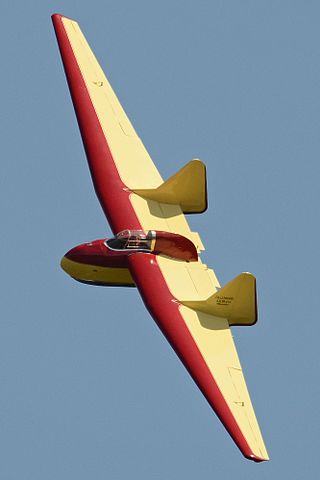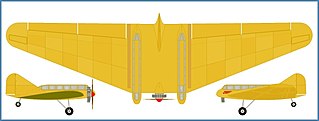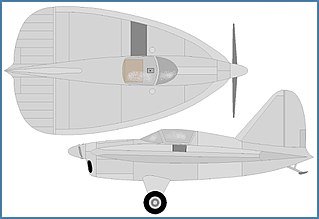
The General Aircraft GAL.56 was a family of 1940s British experimental tailless swept wing glider designs.

The Fauvel AV.36 was a single-seat tailless glider designed in France in the 1950s by Charles Fauvel. Although the "AV" in AV.36 stands for Aile Volante, it was not a true flying wing: it featured two large fins mounted on stubby tailbooms extending back from the wing's trailing edge, and accommodated the pilot within a stubby fuselage. The aircraft was designed to be quickly disassembled for road transport, with the nose detaching, and the fins able to fold back against the trailing edge of the wing. A refined version with a slightly longer wingspan, the AV.361 was introduced in 1960.

The Dunne D.5 was a British experimental aircraft built in 1910. A tailless swept-wing biplane, it was designed by J. W. Dunne and built by Short Brothers at Leysdown for his company, the Blair Atholl Aeroplane Syndicate Ltd. Like its military predecessors it was driven by twin pusher propellers, but it had a considerably more powerful engine.

The Gotha Go 147 was a German experimental two-seat tailless aircraft designed in 1936 by Gothaer Waggonfabrik and Dr. A. Kupper. Two examples were built and flown. Development was abandoned before the start of World War II.
The NRC tailless glider, also called the NRL tailless glider, was a two-seat tailless research glider designed by the National Research Council of Canada and built by the National Research Laboratories, at the instigation of G.T.R. Hill who had previously designed the British Westland-Hill Pterodactyl series of tailless aircraft.

The RRG Storch V was the only member of Alexander Lippisch's Storch series of tailless aircraft to be powered. It flew successfully in the year 1929.

The Kharkiv KhAI-3 or Aviavnito-3 was one of several Soviet mid-1930s motor glider transports intended to reduce transport costs.

The Kharkiv KhAI-4 was an experimental Soviet tailless aircraft tested in 1934. It only made three flights before being grounded as dangerous.
The RRG Delta I was a German experimental tailless aircraft flown in the early 1930s first as a glider and then powered. It was one of the first delta wing aircraft.

The Moskalyev SAM-7 Sigma was a one-off, Soviet, experimental tailless fighter aircraft.

The Moskalyev SAM-9 Strela (Arrow) was a one-off, Soviet, 1930s experimental tailless aircraft designed to test the characteristics of a leaf-shaped low-aspect-ratio delta wing.
The Malliga 1 human powered aircraft was the project of Horst Josef Malliga. It is thought that it was the first successful Continental European human-powered aircraft.
The Goodhart Newbury Manflier was a two-place human-powered aircraft designed by Nicholas Goodhart. Its most notable feature was that the two pilots were placed in separate fuselages, spaced 70 ft apart.

The Wright MPA Mk 1 was the first of two human-powered aircraft designed and built by Peter Wright, an engineer from Melton Mowbray, England.

The Olympian ZB-1 was the first human-powered aircraft to have flown in the United States. It was designed, built, and flown by Joseph A. Zinno, of North Providence, Rhode Island. Zinno had previously been a USAF Lieutenant Colonel, and undertook the challenge of making a human-powered aircraft as a post-retirement project.
The BURD II was a two-place human-powered biplane, designed and built by graduates and undergraduates of the Massachusetts Institute of Technology. It is very similar to the original BURD, which suffered a structural collapse during testing in 1975, but incorporated changes to its structure and its control systems.
The Monarch A was a human-powered aircraft, designed and built by graduates and undergraduates of the Massachusetts Institute of Technology, with Professors Walter Hollister and Ed Crawley acting as Project Advisers. Professor Eugene Larrabee, who had been the adviser for the 1979 MIT Chrysalis HPA, also provided support.
The Dragonfly was a human-powered aircraft, designed and built by the Prestwick Man Powered Aircraft Group, based at the Prestwick International Airport in South Ayrshire, Scotland.
The Halton Jupiter was a human-powered aircraft which established distance and duration records in the early 1970s.

The Phoenix was a human-powered aircraft, designed and built in the 1980s by the British architect Frederick To. It was notable for being an inflatable tailless design and for its low airspeed.












